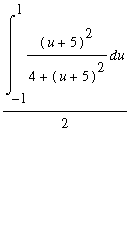
MATH 371 -- Numerical Analysis
November 14, 2001
Further Gaussian Quadrature Examples
First let's continue our work with

The Gaussian Quadrature approximation with
![]()
> f:=x->x^2/(1+x^2);

> x[5,1]:=-.9061798459:
> x[5,2]:=-.5384693101:
> x[5,3]:=0:
> x[5,4]:=-x[5,2]:
> x[5,5]:=-x[5,1]:
> c[5,1]:=.2369268850:
> c[5,2]:=.4786286705:
> c[5,3]:=.5688888889:
> c[5,4]:=c[5,2]:
> c[5,5]:=c[5,1]:
> GQ5approx:=add(c[5,j]*f(x[5,j]),j=1..5);
![]()
The exact value is

> Exact:=evalf(Int(f(x),x=-1..1));
![]()
> GQ5error:=abs(Exact-GQ5approx);
![]()
Let's compare this with the Simpson's Rule approximation using
the same number of function evaluations:
> with(student):
> Simpapprox:=evalf(simpson(f(x),x=-1..1,4));
![]()
> Simperror:=abs(Exact-Simpapprox);
![]()
As expected, the Gaussian Quadrature error is significantly smaller
(by an order of magnitude in this example).
Next, we show how to use Gaussian Quadrature over intervals other
than [-1,1]. For instance, let's see how to approximate
 . First, we make the substitution
. First, we make the substitution

which takes the x- interval [2,3] to the u- interval [-1,1]. Under
this substitution, the integral to be computed becomes

> g:=u->(u+5)^2/(4+(u+5)^2)*(1/2);

> GQ5approx:=add(c[5,j]*g(x[5,j]),j=1..5);
![]()
> Exact:=evalf(Int(f(x),x=2..3));
![]()
> GQ5Error:=abs(Exact-GQ5approx);
![]()
This is much more typical of the behavior of the 5-point Gaussian Quadrature
error than the first example is!
> Simpapprox:=evalf(simpson(f(x),x=2..3,4));
![]()
> Simperror:=abs(Exact-Simpapprox);
![]()
>